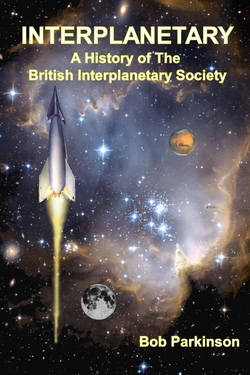Centauri Dreams
Imagining and Planning Interstellar Exploration
Modeling Climates at TRAPPIST-1
It’s a long name, but with the successful arrival of the Interior Exploration using Seismic Investigations, Geodesy and Heat Transport (InSight) lander on Mars, we now go to work on the planet’s deep interior. With Centauri Dreams‘ deep space perspective, my thoughts quickly turn to other stellar systems. We’ve all seen how hard it is to land on Mars, and have looked up into the night sky to find the ruddy pinprick that marks its naked eye presence. Given our Solar System’s scale, the task of getting humans to Mars looms as a major challenge.
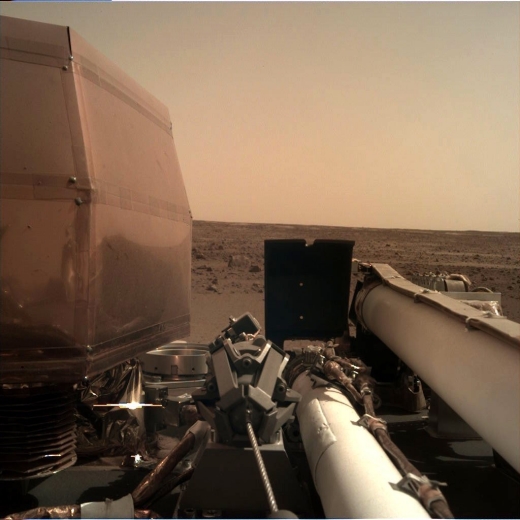
Image: Who can resist the first clear photo from a Mars mission? Not me. Credit: NASA.
But suppose we were on a planet in the TRAPPIST-1 system. Here we have roughly Earth-sized planets packed into tight proximity around the parent red dwarf. TRAPPIST-1b is at 0.011 AU, while TRAPPIST-1c is at 0.015 AU. Even the most distant from the star, TRAPPIST-1h, orbits at 0.062 AU, so that these seven worlds are all closer to the host than Mercury in our system. TRAPPIST-1b and TRAPPIST-1c are no more than 1.6 times the distance between the Earth and the Moon apart.
With significant celestial targets this numerous and this obvious in the sky, would any civilization emerging in such a system not have a greater incentive to become spacefaring at an early stage in its development? Imagine another planet, perhaps with atmosphere and ecosystem of its own, looming larger than the Moon in our skies. And others not so much farther away.
Climate Among the Seven Worlds
Space telescopes have limited resources and they’re expensive to operate. Better, then, that we figure out as much as we can about potential objects of study before we even launch such tools as the James Webb Space Telescope, now expected to be sent aloft in 2021. Thus climate models of the TRAPPIST-1 planets are becoming something of a cottage industry.
Now we have a new paper out of the University of Washington that offers rigorous physical modeling both of the radiation environment and chemistry in the system. The models create spectral signatures for each of the possible gases in TRAPPIST-1 atmospheres.
“We are modeling unfamiliar atmospheres, not just assuming that the things we see in the solar system will look the same way around another star,” said Andrew Lincowski, UW doctoral student and lead author of a paper published Nov. 1 in the Astrophysical Journal. “We conducted this research to show what these different types of atmospheres could look like.”
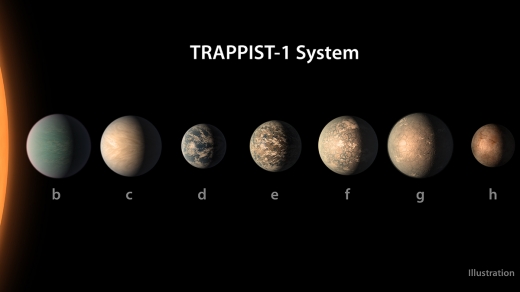
Image: The small, cool M dwarf star TRAPPIST-1 and its seven worlds. New research from the University of Washington speculates on possible climates of these worlds and how they may have evolved. Credit: NASA.
It’s important to bear in mind that we can’t make G-class star assumptions about the planets orbiting this M-dwarf, an ultra-cool object not much larger than Jupiter in size and less than a tenth of the mass of the Sun. So when we talk about three of the TRAPPIST-1 planets being near or in the habitable zone where liquid water could exist at the surface, the statement acknowledges how little we know of conditions on any of these worlds.
We have to include the high degree of stellar activity we find on M-dwarf stars, which could disrupt the early atmosphere as well as destroying ozone that could protect life from UV radiation. In its early stages of development, such a star could put a rocky world with an ocean into a runaway greenhouse condition that might persist for hundreds of millions of years before, as the star gradually dims and enters the main sequence, the planet emerges into the habitable zone.
So we can’t expect terrestrial-class planets around these stars to go through the same development as planets around our G-class Sun. When next-generation searches of small rocky worlds finally occur, they will be our first spectrographic analyses of distant atmospheres looking not only for water vapor but a wide range of biosignature gases. Planetary evolution at M-dwarfs clearly needs to be understood to ensure accuracy.
What happens to planetary atmospheres around dim red stars like this one? Using the Hyak supercomputer system at the University of Washington, Lincowski and team modeled the TRAPPIST-1 planets drawing on the methods of terrestrial climate modeling and infusing into them photochemistry models that they believe provide as good a simulation of planetary conditions here as we have yet seen. The number of possibly ‘habitable’ worlds decreases to one. For it turns out that any or all of the TRAPPIST-1 planets could have stronger resemblance to Venus than to Earth, with whatever water once existed at the surface long departed.
“This may be possible if these planets had more water initially than Earth, Venus or Mars,” Lincowski adds. “If planet TRAPPIST-1 e did not lose all of its water during this phase, today it could be a water world, completely covered by a global ocean. In this case, it could have a climate similar to Earth.”
The team’s work models atmospheric conditions after extreme loss of volatiles early in planetary evolution, discriminating between oxygen- and carbon dioxide-dominated atmospheres and including interior outgassing as a contributor to the final composition. For depending on early conditions, water can be broken by ultraviolet light into its constituents. Hydrogen is thus released, which is light enough to escape the planet’s gravity. Oxygen dominates the thick atmosphere left behind, a remnant that has little to do with life. We have no analog to this kind of atmosphere in our own Solar System.
Differentiating among these worlds, the researchers’ modeling offers the insight that if one of these planets is likely to host life, it is TRAPPIST-1e, the world we’ll want to focus on in future astrobiological studies. TRAPPIST-1b appears hotter than Venus. Planets c and d, further out, still receive enough energy from the host to be Venus-like, with any atmosphere likely dense over an uninhabitable surface. As for planets f, g and h, the spread is wide. They could be frozen worlds or, depending on the amount of water at formation, Venus-like themselves.
The amount of water available to these worlds early in their formation is key here, and plays against the team’s calculations of ocean loss and oxygen accumulation for all seven of the TRAPPIST-1 planets. From the paper:
Our evolutionary modeling suggests that the current environmental states can include the hypothesized desiccated, post-ocean-runaway O2-dominated planets, with at least partial ocean loss persisting out to TRAPPIST-1 h. These O2-dominated atmospheres have unusual temperature structures, with low-altitude stratospheres and no tropospheres, which result in distinctive features in both transmission and emission, including strong collision-induced absorption from O2.
Thus we have a possible signature to look for in future observations. Or we could get atmospheres much more similar to Venus:
Alternatively, if early volatile outgassing (e.g. H2O, SO2, CO2) occurred, as was the case for Earth and Venus, Venus-like atmospheres are possible, and likely stable, throughout and beyond the habitable zone, so the maximum greenhouse limit may not apply for evolved M dwarf planets. If Venus-like, these planets could form sulfuric acid hazes, though we find that TRAPPIST-1 b would be too hot to condense H2SO4 aerosols.
What a prize TRAPPIST-1 has turned out to be. The authors call these worlds “…a natural laboratory to study planetary atmospheric evolution and the associated impact on habitability.”
Consider: We have seven transiting planets that range from well inside the putative habitable zone to well past its outer boundaries. The paper points out how useful this is in examining planet evolution as a function of distance from a star. Moreover, because of their orbital configuration, these planets make frequent transits and offer small star-to-planet ratios, which provide optimum values of signal to noise in the transit signature. We’ll see continued modeling of possible outcomes here as we gear up for next generation observations.
Co-author Victoria Meadows, principal investigator for the NASA Astrobiology Institute’s Virtual Planetary Laboratory at the University of Washington, adds:
“The processes that shape the evolution of a terrestrial planet are critical to whether or not it can be habitable, as well as our ability to interpret possible signs of life, This paper suggests that we may soon be able to search for potentially detectable signs of these processes on alien worlds.”
The paper is Lincowski et al., “Evolved Climates and Observational Discriminants for the TRAPPIST-1 Planetary System,” Astrophysical Journal Vol. 867, No. 1 (1 November 2018). Abstract / Preprint.

HR 8799c: Water Detection Moves Spectroscopy Forward
Some relatives of a friend recently made me realize how routine exoplanet discoveries have become to the public. These are anything but astronomy buffs, but they know that planets can be found without ever being seen. My acquaintances may not understand radial velocity or transits to any high degree, but they accept that the methods are there and have proven reliable. “Someday,” said one, “I guess we’ll actually see one of these planets.”
The image below came as a surprise when I showed it to them. Here we do see a planetary system, four actual planets around the star HR 8799 and not just jiggles in Doppler signals or dips in a lightcurve. For me, what’s astonishing here is not only that we can see planets despite their proximity to the host, but that we’ve accomplished this with telescopes on the ground. Adaptive optics — correcting for turbulence in the atmosphere that would distort an astronomical image, using a guide star as a reference — is the tool that is opening a new era in astronomy from the surface of the Earth. Couple it with spectroscopy and a world of possibilities emerges.
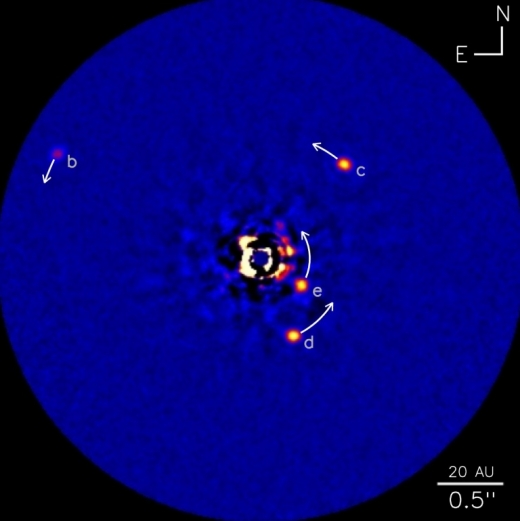
Image: The HR 8799 planetary system is the first stellar system beyond our own that astronomers directly imaged. Captured in 2008 using Keck Observatory’s near-infrared adaptive optics, the picture revealed three planets (labeled ‘b’, ‘c’, and ‘d’) orbiting a dusty young star named HR 8799 (center). In 2010, the team announced they detected a fourth planet in the system (labeled ‘e’). The HR 8799 system is located 129 light-years away from Earth. Credit: NRC-HIA/C. Marois/W. M. Keck Observatory.
We have over a dozen directly imaged exoplanets at this point, but HR 8799 gives us the first multiple planet system to be so viewed. A newly published study reports on the use of a high-resolution spectrometer called NIRSPEC (near-infrared cryogenic echelle spectrograph) that works at infrared wavelengths. Built at the UCLA Infrared Laboratory, it has detected water in the atmosphere of HR 8799c, a gas giant of 7 Jupiter masses in a 200 year orbit. The work also demonstrates a lack of methane in data from an instrument sensitive enough to find it.
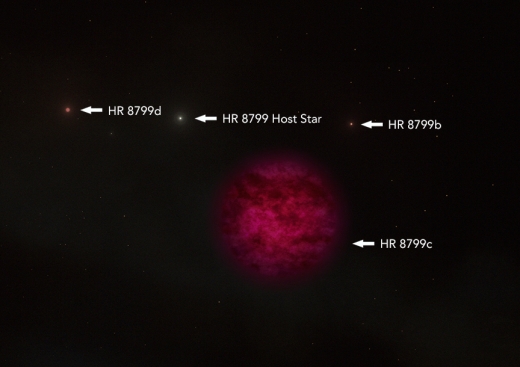
Image: Artist’s impression based on published scientific data on the HR 8799 solar system. The magenta, HR 8799c planet is in the foreground. Compared to Jupiter, this gas giant is about seven times more massive and has a radius that is 20 percent larger. HR 8799c’s planetary companions, d and b are in the background, orbiting their host star. Credit: W. M. Keck Observatory/Adam Makarenko/C. Alvarez.
The Keck II study combines the high spatial resolution of adaptive optics with the high spectral resolution of NIRSPEC. Lead author Ji Wang (Ohio State University) and team explain that this is the first time a directly imaged planet has been investigated with spectrometer and adaptive optics using the L-band, a wavelength around 3.5 micrometers. Although challenging for astronomers, this wavelength is rich in markers for chemicals in the target atmosphere.
The lack of methane in HR 8799c’s atmosphere does not come as a surprise, as it confirms earlier analyses:
“We are now more certain about the lack of methane in this planet,” says Wang. “This may be due to mixing in the planet’s atmosphere. The methane, which we would expect to be there on the surface, could be diluted if the process of convection is bringing up deeper layers of the planet that don’t have methane.”
Future work in the L-band, which can make measurements of a planet’s carbon-to-oxygen ratio, will be useful in determining the formation history of directly imaged planets. Protoplanetary constituents including hydrogen, oxygen, water, carbon monoxide and methane each have their own ‘snowline’ where they freeze out from the early planet-forming disk. A planet’s carbon-to-oxygen ratio, then, can be a window into where it formed and its later dynamics.
As we move adaptive optics and high-resolution spectroscopy forward, a new instrument called the Keck Planet Imager and Characterizer will soon see planets that are fainter than the HR 8799 worlds and orbit closer to their stars. Keck astronomers consider it a bridge to the Thirty Meter Telescope planned for the late 2020s. These technologies should be able to analyze the chemical makeup of Earth-like planets in their stars’ habitable zones, looking for potential biosignatures like water, oxygen, and methane. The astrobiology investigation intensifies.
The paper is Wang et al., “Detecting Water in the Atmosphere of HR 8799 c with L-band High-dispersion Spectroscopy Aided by Adaptive Optics,” Astronomical Journal Vol. 156, No. 6 (20 November 2018). Abstract / Preprint.

An Encouraging Formation Scenario for Icy Moons
It makes sense that planets in other stellar systems would have moons, but so far it has been difficult to find them. That’s why Kepler-1625b, about 8,000 light years out in the direction of Cygnus, is so interesting. As we noted last month, David Kipping and graduate student Alex Teachey have compiled interesting evidence of a moon around this gas giant, which is itself either close to or within the habitable zone of its star. The massive candidate exomoon is the size of Neptune, and if confirmed, would mark the first exomoon detection in our catalog.
As the examination of Kepler-1625b and its transit timing variations continues, we have new work out of the University of Zürich, ETH Zürich and NCCR PlanetS that adds weight to the assumption that moons around large planets should be ubiquitous. Using computer simulations run at the Swiss National Supercomputing Centre (CSCS) in Lugano, a team of researchers led by Judit Szulágyi (University of Zurich and ETH Zurich) has determined that both gas giants and ice giants like Neptune and Uranus will produce moon-bearing circumplanetary disks.
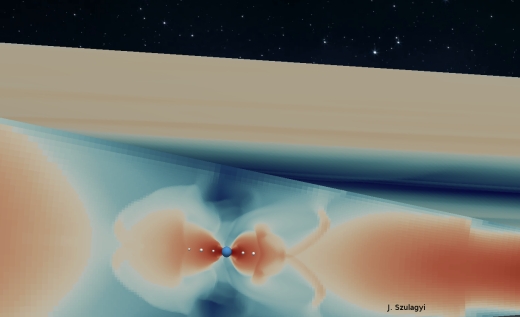
Image: One of the computer simulations on the formation of moons (white bodies) around Neptune (blue sphere). Credit: Judit Szulágyi.
The issue is given point by the difference between Neptune and Uranus when it comes to moons. The five major moons of Uranus do not seem out of place when compared to what we see around Jupiter and Saturn. But we seem to see a different formation history at Neptune, whose solitary major moon, Triton, may well have been captured from the Kuiper Belt.
Szulágyi and team wondered whether the moons of Uranus were not themselves outliers, perhaps formed through a collision in the early days of the Solar System. Our own Moon is thought to have been the result of just such an ancient catastrophe. But the simulations the researchers ran pointed to both Uranus and Neptune originally having their own moon-forming disk of gas and dust. In each case, the simulations produced icy moons. This is a useful result as it has been widely believed that the two ice giants were too light to form such a disk.
The implication: Neptune was itself once orbited by a system of icy moons much like that of Uranus, one that would have been disrupted during the capture of the massive moon Triton. Bear in mind that Triton contains 99 percent of the mass of Neptune’s entire satellite system. The authors point to an earlier study showing that the capture of Triton would only have been possible if Neptune originally had a moon system with the mass of the Uranian moons.
From the paper:
We investigated CPD [circumplanetary disk]- and moon-formation around Uranus and Neptune with combining radiative hydrodynamical simulations with satellite population synthesis. We found that both Uranus and Neptune could form a gaseous disk at the end of their formation, when their surface temperature dropped below 500 K. These disks are able to form satellites in them within a few hundred thousand years. The masses of such satellite-systems for both planets were often similar to the current one around Uranus. All the formed moons must be icy in composition, given that they formed in a CPD that has a temperature below water freezing-point.
All of this has implications for the exomoon hunt, in that the formation of moons seems to be likely across the entire range from gas giant to ice giant. Bear in mind how often we’ve found Neptune-class planets among the population of exoplanet candidates. If such worlds are producing exomoons, then such moons form a larger population than we had realized. Our studies of the Jovian and Saturnian moons have shown how interesting they are in terms of astrobiological possibilities, a realm that now widens as we expand the discovery space.
Says Szulágyi: “[A] a much larger population of icy moons in the Universe means more potentially habitable worlds out there than it was imagined so far. They will be excellent targets to search for life outside the Solar System.”
The paper is Szulágyi, Cilibrasi and Mayer, “In situ formation of icy moons of Uranus and Neptune,” Astrophysical Journal Letters 868 (2018), L13. Abstract / Preprint. Among the papers on Triton as a disrupter of Neptune’s early system of moons, see in particular Rufu & Canup, “Triton’s Evolution with a Primordial Neptunian Satellite System,” Astronomical Journal Vol. 154, No. 5 (2017). Abstract.

Puzzling Out Chariklo’s Rings
The outer system object called Chariklo doesn’t get into the news all that much, so I’m glad that this morning I have the chance to give it its place in the Sun. 10199 Chariklo is a Centaur, moving between the orbits of Saturn and Uranus. With an estimated diameter of 250 kilometers, it’s the largest Centaur known, and as far as I know, the first one known to have a ring system. Another Centaur, Chiron, is also suspected of having rings, but on the latter, researchers have not ruled out other explanations for the observed feature, like symmetrical jets of gas and dust.
With Chariklo, we have data from a 2013 occultation of a distant star that revealed the existence of two rings, one 3 kilometers and the other about 7 kilometers wide, separated by about 9 kilometers. Chariklo’s rings have even been given nicknames — Olapoque for the larger, Chui for the smaller, both the names of Brazilian rivers, though the IAU will have the final say on such matters. Of particular interest since the discovery is the question of what keeps a ring system intact around such a small object. The discovery of rings around Haumea deepens the question.
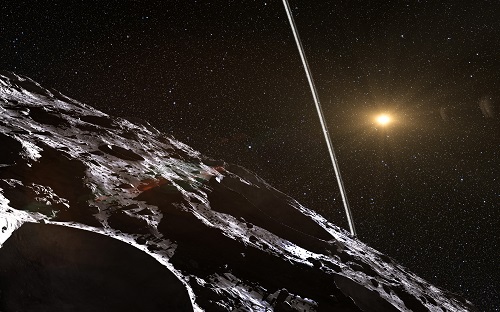
Image: An artist’s impression of the dense and narrow rings around Chariklo. The origin of these rings remains a mystery, but they may be the result of a collision that created a disc of debris. Data from a recent occultation implies that another centaur, Chiron, may also have a ring system, although other explanations are still being examined. Credit: European Southern Observatory.
An interesting new paper speculates that gravity coupled with the odd shapes of both Chariklo and Haumea is the stabilizing factor. At Saturn, we know that so-called ‘shepherd moons’ play a role in stabilizing ring structures. The new work, led by Bruno Sicardy (Observatoire de Paris), focuses on topographical anomalies on the small outer system objects themselves. Co-author Maryame El Moutamid, a research associate in the Cornell Center for Astrophysics and Planetary Science and a member of Cornell’s Carl Sagan Institute, explains:
“Rings appear around Saturn, Jupiter, Neptune and Uranus, but scientists found rings around Chariklo and Haumea within the last few years. Chariklo and Haumea were the first small objects known to have rings, and we think that rings throughout the solar system are more common than we thought. In the case of small bodies Chariklo and Haumea, gravity shepherds the rings. The rings are confined by the gravity because of the shape irregularity of their bodies.”
Thus Chariklo, whose evidently elongated shape includes a large mountain-like feature. The authors believe such topographical anomalies play a role similar to Saturn’s shepherding moons in preventing the ring structure from dissipating. Couple this with the fast rotation of both Chariklo and Haumea, itself an unusually shaped, elongated Kuiper Belt object, and according to the researchers’ simulations, you have all the factors in place to account for ring stability.
So we have a novel mechanism at work here that explains the first ring systems ever found other than those around the giant planets. In contrast to the latter, notes the paper:
…gravitational fields of small bodies may exhibit large non-axisymmetric terms that create strong resonances between the spin of the object and the mean motion of ring particles. Here we show that modest topographic features or elongations of Chariklo and Haumea explain why their rings are relatively far away from the central body, when scaled to those of the giant planets.
The team’s simulations show that these resonances quickly clear out what would have been an early ‘collisional disk’ in the region where the mean motion of the particles matches the object’s spin. Disk material inside this radius falls onto the surface, while material outside the corotation radius is pushed just outside the 1/2 resonance (one rotation of ring particles for every two rotations of the parent body).
Consequently, the existence of rings around non-axisymmetric bodies requires that the 1/2 resonance resides inside the Roche limit of the body, favouring faster rotators for being surrounded by rings.
The Roche limit referenced above refers to the closest a small object can approach the parent body it orbits without being disrupted by tidal forces. The rings, then, stay in place just beyond the Roche limit thanks to the resonances induced partly by unusual topography at the surface.
The paper is Sicardy et al., “Ring dynamics around non-axisymmetric bodies with application to Chariklo and Haumea,” Nature Astronomy 19 November 2018 (abstract). On the original discovery of rings around Chariklo, see Braga-Ribas et al., “A ring system detected around the Centaur (10199) Chariklo,” Nature Vol. 508, Issue 7494 (2014), pp. 72-75 (preprint).

AAVSO Exoplanet Archive for Amateur Astronomers
Even today, I can well understand the reaction that Dennis Conti had when confronted with the prospect of finding a planet around another star with nothing more than an amateur instrument. Conti, who founded and now chairs the Exoplanet Section of the American Association of Variable Star Observers, was a newcomer to the transit method just a few years ago. “I thought, there’s no way for someone with a backyard telescope to detect a planet going around a distant star,” he says, looking back from the vantage of one now immersed in such observations.
My boyhood 3-inch reflector was not a backyard instrument — too many trees back there. So it became a front-yard telescope. Absent the technological innovations of the past five decades, I could only imagine vast instruments for studying objects around other stars. The transit method in exoplanet detection was a long way off, but the idea of seeing not a planet itself but a change in starlight as the planet crossed the face of its host now seems intuitively obvious. It takes a good deal more than a 3-inch reflector to get into the game, but today’s more sophisticated amateur telescopes can definitely make a contribution, as Conti has demonstrated.
Consider: In 2016, Conti coordinated more than 40 amateur astronomers who would assist a professional scientist in characterizing the atmospheres of 15 different exoplanets. A year later, he would begin teaching a course in observing exoplanets through the AAVSO, one that has taught more than 120 students ranging from professional scientists to high-school teachers. His Practical Guide to Exoplanet Observing, now in its 4th revision, is in use in many countries.
The AAVSO is now building its own Exoplanet Database, a useful entry into the field because the increasing amount of data gathered by amateurs should have a unified home. Many existing databases are built around specific space missions or ground-based surveys. The AAVSO’s entry will be a place where amateur astronomers can archive their exoplanet transit observations to make them available to the broader community. Long-term archiving of observations may turn up interesting features in lightcurves like transit timing variations, that could potentially identify the presence of a second planet in the same observed system.
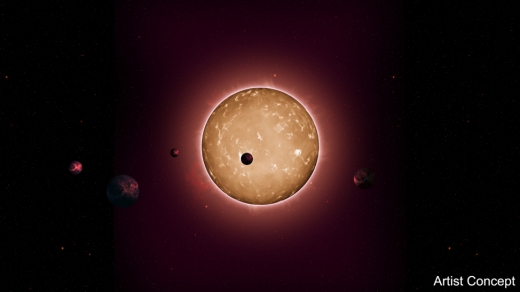
Image: This artist’s concept shows the Kepler-444 planetary system, in which five small planets orbit a distant star. These five planets were detected by the transit method, which involves recording the periodic dimming of a star as a planet transits across its face. Amateur astronomers have been using the same technique to successfully and accurately detect exoplanets for more than a decade, and their observations can now be recorded in the AAVSO’s Exoplanet Database. There, they can be archived long-term and used by professionals and other amateurs to build scientific knowledge of interesting planets. Credit: NASA/JPL-Caltech/AMES/Univ. of Birmingham.
I never followed up with larger home telescopes of my own, but I admire the dedicated amateurs who have plunged into this work. The synergy between amateur and professional can be productive. With TESS (Transiting Exoplanet Survey Satellite) now in operation, we’re reminded that thousands of exoplanet candidates are going to turn up in the next two years. Follow-up observations on the TESS candidates are to be submitted to NASA. The TESS Follow-Up Observing Program is coordinating its efforts with the AAVSO and has adopted its guidelines for best practices, as noted in this AAVSO news release.
“This emphasizes the value that nonprofessionals bring to the field of science,” says Stella Kafka, Ph.D., AAVSO Executive Officer. “People with moderate means can contribute from the ground to the knowledge base of the community. In principle, one can see the AAVSO as an international collaboration between professional and non-professional astronomers, working together to understand some of the most exciting phenomena in the universe.”
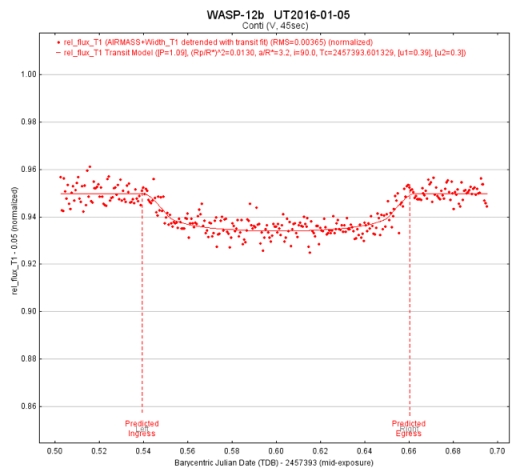
Image: The light curve shown here records the dimming of the exoplanet WASP-12b, taken Jan. 5, 2016, by Dennis Conti, Ph.D., founder and chair of the AAVSO’s Exoplanet Section. Conti used equipment available to amateur astronomers and compared his results to published data to show that he was able to successfully and accurately detect the exoplanet. The AAVSO’s Exoplanet Database will provide a place for amateur astronomers following established procedures to make their exoplanet transit observations available to the broader community of researchers, and to have their data archived long-term. Credit: Dennis Conti.
Many eyes on target with a wide range of instruments are better than a few, and bear in mind that observing an exoplanet transit from different locations and times can help astronomers assemble data on a complete transit that might otherwise be lacking. I’ll also remind non-astronomers with a passion to contribute of the Planet Hunters site, where participants can look at exoplanet data and sort through lightcurves from the Kepler mission. The ways for amateurs to make a contribution to exoplanet science are multiplying.

Crater Beneath the Greenland Ice
A crater roughly the size of the area inside Washington DC’s beltway has been found beneath the Greenland ice. On this, some thoughts, but first, a reminiscence. If you’ve ever driven the Capital Beltway at rush hour, you’ll have some sense of the crater’s size. My own experiences of it have been few, but the most memorable was the afternoon I spent at NASA Goddard Space Flight Center, where Greg Benford was speaking. We had agreed that after his talk, Greg and I would head out for dinner at a local restaurant, the exact venue to be determined later.
It was about 5:00 PM when we were in the GSFC parking lot ready to go, now joined by Gloria Lubkin, editor emerita at Physics Today. With the help of Greg’s nephew Dominic, we had chosen a French restaurant about 10 miles away. The problem: Greg and Gloria were in one car, I was in another, and it was rush hour. An out-of-towner who rarely got to DC, I was not remotely prepared for the beltway under these conditions.
I had no smartphone then, no GPS, and the only recourse was to follow the bumper of Gloria’s car. If I lost Gloria and Greg, I wouldn’t have a clue where to go. I leave it as an exercise for the reader’s imagination what it was like to be in packed lanes of high-speed traffic as night fell trying to stay close enough to the bumper ahead so as not to lose it, while simultaneously ensuring enough distance to avoid a collision. Success seemed doubtful, but we reached the restaurant together, and the meal was a gastronomic and conversational delight.

Image: Ah the Beltway. Now put all this into high-speed motion. Credit: Craig F. Walker/Boston Globe.
Greenland seems a much tamer place. The crater identified here is about 300 meters (1000 feet) deep and over 30 kilometers (19 miles) in diameter. That puts it among the 25 largest impact craters on our planet. Described in the journal Science Advances, the work was led by scientists from the University of Copenhagen’s Centre for GeoGenetics at the Natural History Museum of Denmark. The data feeding this three-year effort came from NASA.
Specifically, NASA’s Operation IceBridge was in play, an airborne mission to study polar ice using ice-penetrating radar, complemented by earlier NASA airborne missions in Greenland. Located at the edge of the ice sheet in northwestern Greenland, the circular depression under Hiawatha Glacier had never been examined, but clear evidence of its existence could be found in satellite imagery from NASA’s Terra and Aqua satellites, which showed a circular pattern.
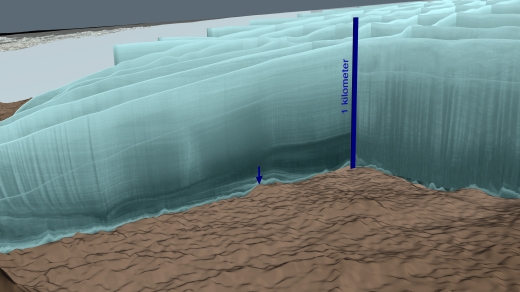
Image: Radar data from an intensive aerial survey of the Hiawatha crater in May 2016 is shown here in aqua-colored curtains. A blue arrow points to the central peak of the crater. Credit: NASA/Cindy Starr.
Subsequent radar maps made the crater’s dimensions clear. Another Beltway reference is the fact that Joe MacGregor, a NASA glaciologist at Goddard Space Flight Center, designed the later airborne mapping survey, using ice-penetrating radar from the University of Kansas. Says MacGregor:
“Previous radar measurements of Hiawatha Glacier were part of a long-term NASA effort to map Greenland’s changing ice cover. What we really needed to test our hypothesis was a dense and focused radar survey there. The survey exceeded all expectations and imaged the depression in stunning detail: a distinctly circular rim, central uplift, disturbed and undisturbed ice layering, and basal debris — it’s all there.”
You would think that glacial ice would quickly remove all trace of a crater, which is why the crater’s preservation after perhaps three million years is considered so unusual. The impactor was evidently an iron meteorite more than 0,8 kilometers (half a mile) wide. Kurt Kjær (Center for GeoGenetics at the Natural History Museum of Denmark), who is lead author on the study, believes the crater may be even younger, perhaps a remnant of an event that occurred toward the end of the last ice age. That would make it among the youngest craters on Earth.
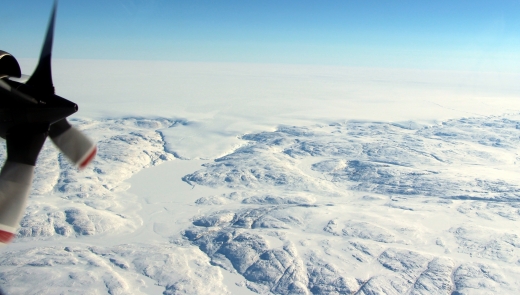
Image: The Hiawatha impact crater is covered by the Greenland Ice Sheet, which flows just beyond the crater rim, forming a semi-circular edge. Part of this edge (top of photo) and a tongue of ice that breaches the crater’s rim are shown in this photo taken during a NASA Operation IceBridge flight on April 17. Credit: NASA/John Sonntag.
The paper goes into considerable detail on the issue of the crater’s age, which remains approximate. Consider this:
The sum of these tentative age constraints suggests that the Hiawatha impact crater formed during the Pleistocene, as this age is most consistent with inferences from presently available data. An impact before the Pleistocene cannot clearly explain the combination of the relative freshness of the crater’s morphology and the ice sheet’s apparently ongoing equilibration with the presence of the crater. We emphasize that even this broad age estimate remains uncertain and that further investigation of the age of the Hiawatha impact crater is necessary. Regardless of its exact age, based on the size of the Hiawatha impact crater, this impact very likely had significant environmental consequences in the Northern Hemisphere and possibly globally.
In 2016 and 2017, researchers returned to Hiawatha Glacier to map tectonic structures and collect samples of sediments emerging from below through a meltwater channel. Here is Nicolaj Larsen (Aarhus University, Denmark), one of the authors of the study:
“Some of the quartz sand coming from the crater had planar deformation features indicative of a violent impact; this is conclusive evidence that the depression beneath the Hiawatha Glacier is a meteorite crater.”
It’s interesting to speculate on other still undiscovered impact craters under ice. They’re a reminder that the Solar System was once a violent place indeed, as the surface of our Moon indicates. There, of course, the processes of wind and water erosion could not take place, so we see stark evidence of ancient impacts. Our planet likewise had its share even if a cursory glance at the globe shows only a few, and the continuing cataloging of near-Earth objects reminds us that a defense against collisions like these is a good insurance policy for our species.
The paper is Kjær et al, “A large impact crater beneath Hiawatha Glacier in northwest Greenland,” Science Advances Vol. 4, No. 11 (14 Nov. 2018). Full text. NASA has produced a helpful video available here.

